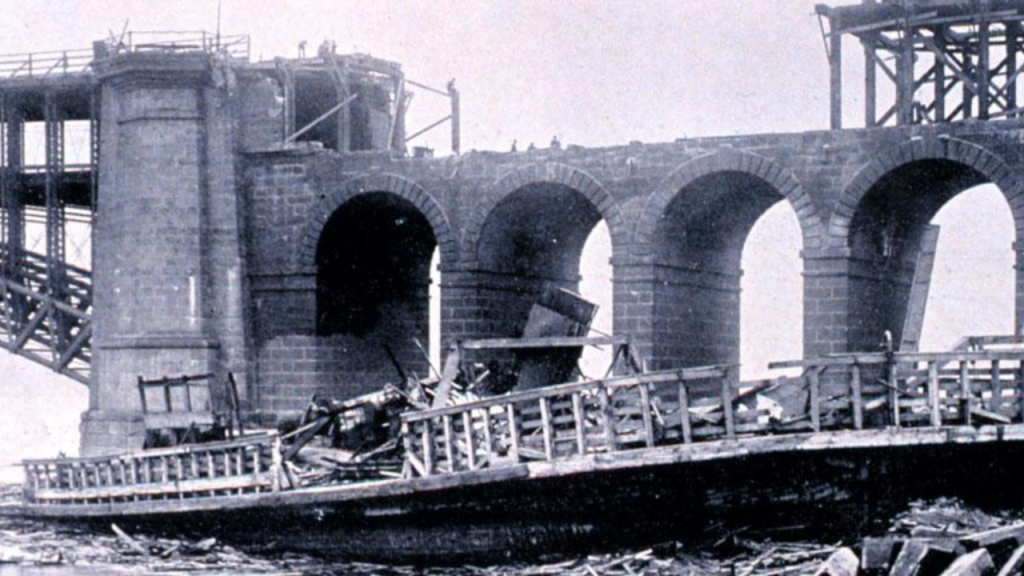
violent tornado ripped through Missouri’s St. Louis and East St. Louis areas, leaving a trail of destruction and loss that shocked the nation. Among the many remarkable stories of that day is how this devastating storm challenged the strength of one of the era’s most advanced engineering marvels: the Eads Bridge, once thought to be “tornado-proof.”
The Eads Bridge: A Symbol of Engineering Brilliance
Completed in 1874, the Eads Bridge was a pioneering feat of engineering. Spanning the Mississippi River, it was the first major bridge constructed entirely of true steel — a material that was revolutionary at the time. Its designer, James B. Eads, was celebrated for creating a structure that combined beauty, utility, and strength.
Due to its advanced construction and materials, the bridge was hailed as “tornado-proof” by many experts and the public alike. It was expected to withstand severe weather events that might topple lesser bridges.
The Great Cyclone of 1896: A Deadly Force of Nature
But on that fateful May evening, nature had other plans.
Around 5:00 p.m., a massive tornado touched down approximately six miles west of the Eads Bridge. This tornado, later known as the Great Cyclone, quickly intensified and tore through St. Louis and East St. Louis in less than half an hour.
The destruction was catastrophic. With winds estimated between 168 and 199 miles per hour—equivalent to an EF4 rating on today’s Fujita scale—the tornado destroyed homes, factories, and infrastructure. The death toll reached at least 255, with more than 1,000 injured, making it one of the deadliest tornadoes in U.S. history.
Entire neighborhoods were flattened, businesses destroyed, and countless lives uprooted. The city’s infrastructure lay in ruins, and the financial damage exceeded $10 million in 1896 dollars—roughly $5 billion today when adjusted for inflation.
The Tornado Meets the Eads Bridge
As the tornado crossed the Mississippi River, it directly impacted the Eads Bridge. Contrary to many expectations, the steel structure itself withstood the enormous forces. The bridge did not collapse or suffer catastrophic failure.
However, the tornado’s tremendous power was still evident in the damage it caused to the bridge’s components and surroundings. One striking piece of evidence revealed the storm’s ferocity: a 2×8-inch plank of white pine was driven straight through a 5/16-inch thick wrought iron plate on the south side of the bridge. This rare event highlighted the intensity of the debris and the violent forces at play.
While the bridge’s core structure remained standing, the surrounding areas and facilities were badly damaged, emphasizing the overwhelming strength of the tornado.
Engineering and Weather: Lessons from 1896
The survival of the Eads Bridge demonstrated the incredible engineering skills of the late 19th century, but it also served as a humbling reminder that even the best human designs have their limits against nature’s most violent forces.
The 1896 tornado pushed scientists, engineers, and city planners to better understand tornado dynamics and their impact on infrastructure. This disaster contributed to the evolution of building codes and storm preparedness measures designed to reduce damage and loss in future storms.
Remembering the Tragedy and the Strength
Today, the Eads Bridge still stands as a functional and historic landmark connecting Missouri and Illinois. It symbolizes the innovative spirit of its era and the resilience of structures designed to endure.
The Great Cyclone of 1896 remains one of the deadliest tornadoes recorded in U.S. history and continues to be studied for insights into tornado behavior, urban vulnerability, and disaster response.
As tornadoes still pose a threat in many parts of the U.S., including Missouri, modern forecasting and safety measures owe much to lessons learned from such historic events.
